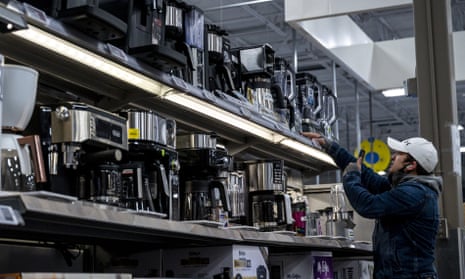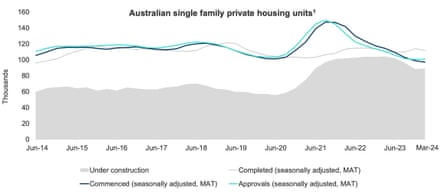
From cars to coffee machines, here’s how Australian spending habits are weathering the high cost of living
Retailers like Temple & Webster have slashed their pricing and tweaked their product range to lure gen Z and millennials – and it’s working
- Get our breaking news email, free app or daily news podcast
Many Australian businesses are feeling the pinch as customers can no longer afford the armchairs, gadgets, clothing brands and new bathrooms they could before the cost of living shot up.
But spending patterns remain uneven, and at times counterintuitive, leading to a mixed corporate earnings season marked by subdued but not collapsing demand.
“There’s no doubt there’s some weakness, but the main thing is that most people still have a job,” said Luke McMillan, the head of research at Sydney-based Ophir Asset Management.
“They’ve generally been solid earnings so far, but we are not out of the woods in terms of a recession.”
Here are three things we’ve learned so far from the full-year reporting season that winds up at the end of August.
-
1. Car yards
After a prolonged period of long wait times and high vehicle prices, the tide has turned in favour of prospective car buyers.
Global vehicle manufacturing has rebounded strongly from pandemic disruptions, resulting in a surplus supply of vehicles to car yards. At the same time, financially stretched consumers are placing fewer orders, opting to either keep their current vehicle or buy secondhand.
“These global supply trends caused increasing inventory levels, greater competition between dealers and lower new car margins,” said Paul Warren, chief executive of Peter Warren Automotive.
The new and used car retailing business reported a 30.6% slide in before tax profit during the financial year, to $56.8m.

Photograph: Eagers Automotive Keith Thornton, chief executive at Eagers Automotive, told investors that consumers were proving resilient but higher interest rates were weighing on buying decisions.
“The RBA’s monetary policy measures are having their desired effect in the automotive industry with reduced discretionary spending in the retail sector and shift to more value-conscious buying,” Thornton said.
Most dealers are offering steeper discounts to entice customers to visit their car yards or online sites, reversing a trend of escalating vehicle prices early in the pandemic.
In further signs of consumer weakness, Origin Energy reported a jump in bad debts from struggling customers, while mortgage arrears continue to climb at major lenders, including Commonwealth Bank.
-
2. Coffee shots
The earnings season has not been without its bright spots.
Shares in home appliance manufacturer and distributor Breville surged after recording a year of record sales, despite the broader weakness in consumer spending.
That uplift was underpinned by double-digit growth from its coffee category, with strong sales overseas, particularly in the US, as demand for espresso grows. Sales were also healthy in Australia.
Coffee lovers have helped Breville capture all parts of the value chain, with the company offering machines that cost a few hundred dollars right through to its top-of-the-line $3,699 contraption.
Online furniture and homewares retailer Temple & Webster was another company that pleased shareholders after it recorded an increase in active customers to 1.1 million from 832,000 a year earlier.
The retailer has carved out a profitable path by selling online to millennials and gen Z, and has adjusted its product range and pricing to cater to the cost-of-living pressures weighing on its customers.
Temple & Webster recorded a reduction in the value of its average order, however, showing retailers can’t completely outrun the financial strain faced by customers.
-
3. Home renos and mortgages
While the renovation sector is usually resilient during economic downturns, companies that supply materials and products for building and home upgrades have reported subdued results due to the effects of elevated mortgage rates.
Companies like bathroom products supplier Reece and plumbing manufacturer Reliance Worldwide are looking for interest rate cuts to give homeowners some confidence.
“If interest rates do change, that will signal a point where the psychology might start to change,” Reece’s chief executive, Peter Wilson, said after the company’s annual results.

Photograph: Reece Group Reliance’s chairman, Stuart Crosby, said elevated rates had “reduced consumer appetite for remodelling activity” and that the company’s outlook is partly dependent on future rate movements.
Australian households have grappled with a rapid-fire 13 interest rate hikes and high rents, as well as rising costs for essential items such as electricity and food, leaving less room in the budget for remodelling their homes.
The Reserve Bank has signalled it may lift rates higher to combat “persistently high inflation”, in contrast to the rate cuts by other central banks including in New Zealand and Canada.
David Robertson, chief economist at Bendigo Bank, said age cohorts are experiencing the effects of the inflation shock differently, leading to mixed spending patterns.
“Consumer demand is clearly under pressure, but it’s uneven by location, by sector and by cohort,” said Robertson.
“Spending is constrained but it’s not collapsing. We are also seeing that resilience in the labour market, where the unemployment rate is creeping higher but we have a record number of people with a job.”
Robertson said that while he did not expect households to spend their stage-three tax cuts and energy rebates on discretionary items, it did create a “tailwind” for household incomes, offsetting some of the strain caused by elevated borrowing rates.